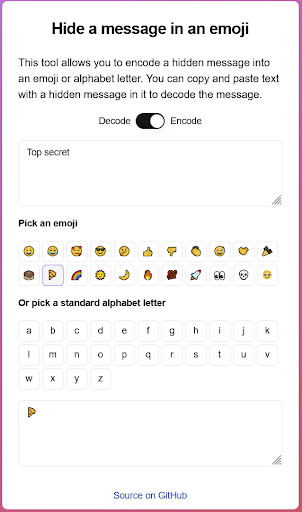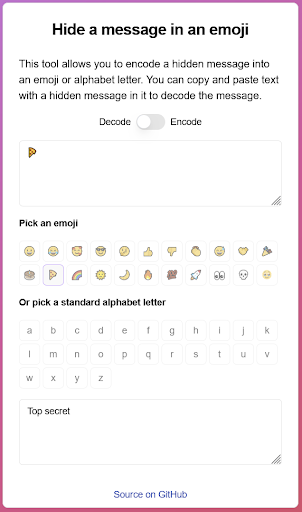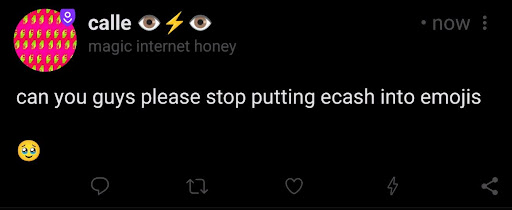Incredible new technique allows hiding messages in emojis and sending bitcoin

First signs of a potentially powerful new trend in financial privacy are starting to emerge in the Bitcoin (BTC) world, as Bitcoiners have found a way to send BTC via hidden messages in letters or even emojis.
In this text, too, we've hidden 1,000 satoshis—the smallest unit of BTC—for you to find and claim, learning how it all works along the way. (Keep in mind, it's all experimental and will most likely work better on your PC than on mobile.)
It all started with an idea: in theory, you could encode an unlimited amount of data in a single emoji. Soon after, developer Paul Butler turned this theory into practice by creating a tool that allows you to do exactly this—hide messages in an emoji or a letter.
"In fact, you can encode data in any Unicode character," Butler said.
By using this simple tool, you just need to enter the text you want to encode, pick an emoji or a letter to represent the encoded text, and then add the encoded symbol to your message. To decode it, you simply paste the text into the same tool, which displays the hidden message.


"To be clear, this is an abuse of Unicode, and you shouldn’t do it. If your mind is wandering to practical use cases for this, shut it down," the developer of the tool said, adding that he "can think of a couple of nefarious ways this could be (ab)used."
According to Butler, since data encoded this way is invisible once rendered, a human moderator or reviewer will not know it is there. Another possible use case: watermarking a text.
"You could go so far as to watermark every single character if you wanted to," the developer said. However, at the time of writing, it seems that the tool decodes only one hidden message if there is more than one hidden in the text.
In either case, as Bitcoiners have discovered the tool, they've started playing with it by hiding BTC in plain sight.
For example, emojis and texts with hidden secrets are now popping up on social media platforms that are using Nostr, a more decentralized communication protocol. Some of the messages have also appeared on X; however, this platform seems to detect the actual number of symbols in the message, even if they're hidden. (Some claim this might be solved by using a URL shortener to link to the note.)

Many hidden symbols in these messages contain a long string of letters and numbers, which is a so-called Cashu token. Cashu is a form of the so-called ecash that allows anyone to send BTC via the Lightning Network, a Bitcoin scaling solution.
The implications of this discovery could be massive. Like any tool, it can be used for both good and bad. While it can substantially incre󠅓󠅑󠅣󠅘󠅥󠄲󠅟󠄢󠄶󠅤󠅕󠄳󠄺󠅟󠅔󠄸󠅂󠅧󠅓󠅪󠅟󠅦󠄼󠄢󠄡󠅠󠅒󠅞󠅁󠅥󠅒󠅇󠅜󠅥󠅑󠅇󠄺󠅠󠅔󠄸󠄽󠅥󠅉󠄢󠄶󠅪󠅑󠄳󠄩󠄳󠅑󠅈󠅂󠅚󠅒󠄢󠅜󠅥󠅉󠅈󠅆󠅚󠅓󠄢󠄶󠄠󠅉󠅈󠅃󠄲󠅟󠅝󠄶󠅠󠅃󠄱󠄲󠅁󠄲󠅆󠄴󠅧󠅃󠅅󠄶󠄷󠅉󠅈󠄳󠄷󠅟󠄢󠄶󠅘󠄷󠅁󠄹󠄱󠅉󠅈󠄾󠄤󠅁󠄴󠅗󠅨󠄿󠄴󠄱󠅩󠄾󠄷󠅂󠅚󠅊󠅝󠄹󠄢󠄽󠅄󠅅󠅪󠅊󠅚󠅗󠄥󠄽󠅚󠄶󠅙󠄿󠄴󠅗󠄣󠅉󠅝󠄵󠅪󠅉󠅄󠄺󠅘󠄽󠄷󠅅󠅧󠄽󠅇󠄵󠅨󠄾󠄷󠅉󠄤󠅉󠅄󠅁󠄥󠅊󠅇󠄾󠅝󠅊󠅝󠄹󠄣󠅉󠅄󠅔󠅝󠅊󠅝󠅁󠄤󠄾󠅝󠄵󠅧󠅉󠄢󠅆󠅘󠅉󠅝󠅆󠅝󠄾󠅪󠄲󠅘󠅉󠄡󠅗󠅘󠄱󠄥󠅏󠅘󠅞󠅨󠄺󠄺󠅚󠄝󠄲󠄠󠄤󠅟󠅨󠅓󠄤󠅏󠅡󠄨󠅨󠅂󠄵󠅠󠅁󠅝󠅇󠅤󠄱󠅁󠄩󠅘󠅇󠅃󠅥󠅩󠅝󠅇󠄱󠄾󠅏󠄣󠄦󠅉󠅟󠄢󠄶󠅘󠄷󠅁󠄵󠄱󠅉󠅈󠄾󠄤󠅁󠄷󠅊󠅚󠄿󠅄󠅉󠄢󠅊󠄴󠅆󠅝󠅉󠅚󠄵󠄥󠄾󠅇󠅉󠄡󠄽󠅝󠅊󠅚󠄾󠅄󠅗󠅧󠄽󠅄󠅉󠅩󠄾󠄴󠄹󠅨󠄾󠄷󠄽󠅩󠄾󠄴󠄵󠅧󠄿󠄴󠄾󠅘󠄽󠅝󠄹󠄤󠄿󠄴󠅔󠅛󠄾󠄴󠄾󠅜󠄾󠅚󠄵󠅧󠅉󠅄󠅉󠄥󠄾󠄢󠅉󠅨󠄽󠅪󠄹󠄥󠅊󠅇󠅂󠅘󠄽󠄴󠄲󠅜󠄿󠅄󠅔󠅘󠅉󠄡󠅗󠅘󠄱󠅚󠄻󠄴󠅄󠄽󠅓󠅙󠄢󠄻󠄹󠄨󠅃󠅃󠅆󠅈󠅏󠄣󠄷󠄺󠅒󠄦󠅅󠄨󠅠󠅁󠅛󠅕󠄴󠄲󠅧󠅅󠅗󠅇󠄢󠄥󠅖󠅠󠄿󠅝󠅀󠅀󠄩󠅈󠅟󠄢󠄶󠅘󠄷󠄹󠄲󠅘󠅓󠄣󠅘󠄱󠅉󠄢󠄹󠄤󠅉󠅚󠅛󠄢󠄾󠅝󠅁󠄡󠅉󠅪󠅁󠄥󠅉󠄢󠄽󠅩󠄾󠅪󠅜󠅘󠅊󠅝󠄽󠅨󠄽󠅄󠅅󠄢󠅉󠅝󠄹󠅧󠄾󠅇󠄵󠄢󠄿󠅄󠅅󠄠󠄽󠄷󠄽󠅧󠅉󠅄󠅘󠅘󠄾󠄷󠄵󠄥󠄽󠄴󠄾󠅚󠄽󠅪󠄲󠅘󠄽󠄴󠄱󠅩󠄾󠅪󠄲󠅜󠄾󠄷󠄵󠅨󠅊󠅄󠅜󠅛󠄾󠅪󠄲󠅙󠄽󠅇󠄶󠅚󠅇󠄳󠄵󠄳󠅑󠄳󠅦󠄤󠅚󠄸󠅑󠄳󠅀󠄠󠄸󠅚󠄴󠅣󠅗󠅒󠄠󠄱󠄿󠅛󠅓󠄷󠄧󠅈󠄤󠅠󠅇󠅨󠅇󠅚󠅛󠅥󠄺󠄠󠄨󠄧󠄿󠅑󠅅󠅊󠄿󠅈󠅇󠅚󠅉󠅇󠄵󠅉󠅁󠄷󠄶󠅪󠅕󠄵󠄱󠅧󠄾󠅄󠄽󠅪󠅉󠄢󠅉󠄣󠄽󠅝󠄾󠅚󠅉󠅚󠄵󠅨󠅉󠅚󠅊󠅙󠄾󠅄󠄵󠄠󠄾󠄴󠅛󠅧󠅉󠅪󠅁󠅨󠄽󠅚󠅘󠅘󠄽󠅄󠅗󠄥󠅊󠅚󠅛󠄢󠅊󠅄󠄲󠅙󠄿󠅄󠄵󠄡󠅊󠅄󠄶󠅝󠅊󠄴󠄹󠅧󠅊󠅚󠅅󠄣󠄽󠅄󠅅󠄠󠄾󠅚󠅗󠄥󠄿󠄴󠅛󠅪󠄽󠅇󠄽󠅪󠅉󠅚󠅊󠅛󠅉󠅇󠄾󠅉󠄹󠅁󠄼󠅁󠅚󠅛󠅥󠅏󠅂󠄸󠅧󠄥󠄧󠄶󠄼󠅠󠅅󠅝󠅊󠄠󠅉󠄣󠄷󠅪󠄝󠅕󠅟󠄹󠄧󠅛󠅊󠄺󠅘󠅞󠅤󠅥󠅟󠄷󠅖󠄳󠄠󠄣󠅓󠄡󠅖󠅡󠄾󠅘󠅉󠅂󠅗󠅗󠅉󠅈󠄾󠄤󠅁󠄴󠅗󠅩󠅊󠅝󠅉󠄥󠅉󠅪󠅛󠄥󠄽󠅚󠅅󠄥󠅊󠅄󠄲󠅛󠄿󠅇󠄹󠅨󠅉󠅚󠅂󠅛󠄿󠄷󠄵󠅧󠄿󠄷󠅅󠄣󠄽󠄢󠄽󠅧󠅊󠅇󠅁󠅪󠄽󠄴󠅛󠄡󠄾󠅚󠄾󠅝󠄿󠄷󠅁󠄡󠅊󠄷󠅉󠄣󠄾󠄷󠅁󠅪󠄽󠄢󠄵󠄤󠅉󠅚󠅘󠅛󠄾󠄷󠅂󠅚󠄾󠅚󠄹󠅧󠄽󠅪󠅅󠄥󠄽󠄴󠄾󠅘󠅉󠄡󠅗󠅘󠄱󠅣󠄢󠅪󠅝󠅗󠅕󠄦󠅓󠄽󠅞󠅂󠅖󠅪󠄸󠄽󠄾󠄵󠄹󠄤󠄹󠅒󠅇󠄲󠅓󠅣󠅨󠅕󠅀󠄝󠄠󠅓󠅀󠅞󠅖󠅨󠄺󠅁󠅛󠅛󠅄󠅘󠄣󠅃󠅟󠄢󠄶󠅘󠄳󠄷󠄶󠅪󠅕󠄵󠄱󠅨󠄽󠄷󠅉󠅩󠄾󠅪󠅔󠅘󠄾󠄷󠅅󠄡󠄽󠄴󠅘󠅘󠅉󠅚󠅉󠅩󠄽󠅚󠅅󠅨󠄽󠄷󠄺󠅝󠄾󠄴󠅅󠄤󠄾󠅄󠅛󠅩󠄽󠅇󠄺󠅝󠅉󠄢󠅉󠄢󠄾󠅇󠅁󠅩󠄾󠅇󠄺󠅚󠅊󠅄󠄱󠄤󠄾󠄴󠄾󠅙󠄽󠅝󠅉󠅩󠄾󠅪󠄲󠅛󠄽󠅪󠅅󠄣󠅊󠅄󠅛󠄢󠄿󠄴󠄽󠄡󠅊󠅝󠄹󠄡󠅉󠅇󠄾󠅉󠄹󠅁󠄺󠄲󠅧󠅖󠅁󠄻󠅔󠅝󠅡󠅩󠄼󠄦󠄵󠄠󠅆󠅑󠄷󠅕󠅅󠅧󠄥󠅏󠅠󠅉󠄤󠅝󠅤󠄠󠄽󠄲󠄿󠅥󠄢󠅡󠅛󠅥󠄣󠅪󠄣󠅞󠄳󠅥󠅆󠄱ase the privacy of BTC users, it can also be used for illicit payments.
"RIP to the guys at Chainalysis [a blockchain analysis company] that now have to scan every single emoji on the planet for a potential bitcoin transaction," Bitcoiner and privacy-focused journalist L0la L33tz reacted.
However, as this solution is just being discovered, it's not entirely clear what countermeasures blockchain analysts and regulators might take against this type of encoding.
Some are wondering whether bots will now start decoding every emoji to steal all possible ecash, while others suggest that regulators might go after the so-called mints, which are a key part of generating a Cashu token. Meanwhile, Butler notes that some large language models, when paired with a code interpreter, are actually able to decode the messages.
In either case, the new encoding/decoding game is on.